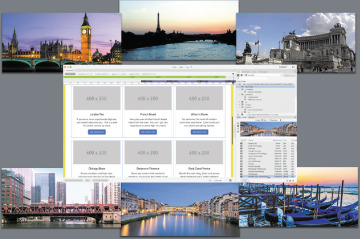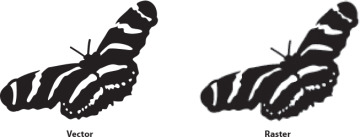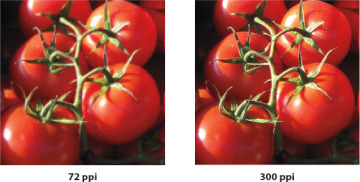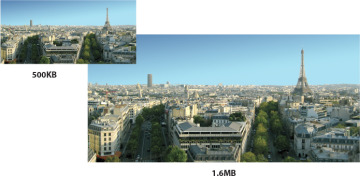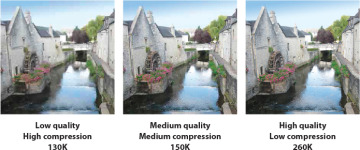Working with Images
Learn how to work with images and include them in your webpages using Adobe Dreamweaver (2021 release). Author James J. Maivald covers web image basics including resolution and file formats, responsive images that fit different devices and screen sizes, Dreamweaver tools to resize, crop, and resample web-compatible images, and more.
Web image basics
The web is not so much a place as it is an experience. Essential to that experience are the images and graphics—both still and animated—that populate most websites. In the computer world, graphics fall into two main categories: vector and raster.
Vector graphics
Vector graphics are created by math. They act as discrete objects that you can reposition and resize as many times as you want without affecting or diminishing their output quality. The best application of vector art is wherever geometric shapes and text are used to create artistic effects. For example, most company logos are built from vector shapes.
Vector graphics are typically stored in the AI, EPS, PICT, or WMF file formats. Unfortunately, most web browsers don’t support these formats. The vector format that is supported is SVG (Scalable Vector Graphic). The simplest way to get started with SVG is to create a graphic in your favorite vector-drawing program—such as Adobe Illustrator or CorelDRAW—and then export it to this format. If you are a good programmer, you may want to try creating SVG graphics using XML (Extensible Markup Language). Visit www.w3schools.com/html/html5_svg.asp to find out more about creating SVG graphics.
Raster graphics
Although SVG has definite advantages, web designers primarily use raster-based images in their webpages. Raster images are built from pixels, which stands for picture elements. Pixels have three basic characteristics:
They are perfectly square in shape.
They are all the same size.
They display only one color at a time.
Raster-based images are composed of thousands, even millions, of pixels arranged in rows and columns, in patterns that create the illusion of an actual photo, painting, or drawing. It’s an illusion, because there is no real photo on the screen, just a bunch of pixels that fool your eyes into seeing an image. And as the quality of the image increases, the illusion becomes more realistic. Raster image quality is based on three factors: resolution, size, and color.
Resolution
Resolution is the best known of the factors affecting raster image quality. It is the expression of image quality measured in the number of pixels that fit in 1 inch (ppi). The more pixels you can fit in 1 inch, the more detail you can depict in the image. But better quality comes at a price. An unfortunate byproduct of higher resolution is larger file size. That’s because each pixel must be stored as bytes of information within the image file—information that has real overhead in computer terms. More pixels means more information, which means larger files.
Luckily, web images have to appear and look their best only on computer screens, which are based mostly on a resolution of 72 ppi. This is low compared to other applications or types of output—such as professional four-color printing—where 300 dpi is considered the lowest acceptable quality. The lower resolution of the computer screen is an important factor in keeping most web image files at a reasonable size for downloading from the internet.
Size
Size refers to the vertical and horizontal dimensions of the image. As image size increases, more pixels are required to create it, and therefore the file becomes larger. Since graphics take more time to download than HTML code, many designers in recent years have replaced graphical components with CSS formatting to speed up the web experience for their visitors. But if you need or want to use images, one method to ensure snappy downloads is to keep image size small. Even today, with the proliferation of high-speed internet service, many websites still avoid using full-screen graphics, although that too has changed.
Color
Color refers to the color space, or palette, that describes each image. Most computer screens display only a fraction of the colors that the human eye can see. And different computers and applications display varying levels of color, expressed by the term bit depth. Monochrome, or 1-bit color, is the smallest color space, displaying only black and white, with no shades of gray. Monochrome is used mostly for line-art illustrations, for blueprints, and to reproduce handwriting or signatures.
The 4-bit color space describes up to 16 colors. Additional colors can be simulated by a process known as dithering, where the available colors are interspersed and juxtaposed to create an illusion of more colors. This color space was created for the first color computer systems and game consoles. Because of its limitations, this palette is seldom used today.
The 8-bit palette offers up to 256 colors or 256 shades of gray. This was the basic color system of all computers, mobile phones, game systems, and handheld devices. This color space also includes what is known as the web-safe color palette. Web-safe refers to a subset of 8-bit colors that are supported on both Mac and Windows computers. Most computers, game consoles, handheld devices, and even phones now support higher color palettes, so 8-bit is not as important anymore. Unless you need to support non-computer devices, you can probably disregard the web-safe palette altogether.
Today, only a rare cellphone or handheld game supports the 16-bit color space. This palette is named high color and sports a grand total of 65,000 colors. Although this sounds like a lot, 16-bit color is not considered good enough for most graphic design purposes or professional printing.
The highest color space is 24-bit color, which is named true color. This system generates up to 16.7 million colors. It is the gold standard for graphic design and professional printing. Several years ago, a new color space was added to the mix: 32-bit color. It doesn’t offer any additional colors, but it provides an additional 8 bits of data for an attribute known as alpha transparency.
Alpha transparency enables you to designate parts of an image or graphic as fully or partially transparent. This trick allows you to create graphics that seem to have rounded corners or curves and can even eliminate the white bounding box typical of raster graphics.
As with size and resolution, color depth can dramatically affect image file size. With all other aspects being equal, an 8-bit image is more than seven times larger than a monochrome image. And the 24-bit version is more than three times larger than the 8-bit image. The key to the effective use of images on a website is finding the balance of resolution, size, and color to achieve the desired optimal quality.
Optimizing your images is essential, even as more people get smartphones and tablets, because there are still millions of people all across the United States, and around the world, who don’t have high-speed wired access to the internet. The FCC released a report 2020 describing the state of broadband access and adoption in the United States. This report indicates that 19 million American do not have access to broadband and that, more importantly, 100 million who do have access have not subscribed to a service. That means almost one-third of America does not have high-speed internet. Check out https://tinyurl.com/broadband-coverage to see the specific details. While using large, colorful images on the web is very popular, it could also cause severe problems for your target audience, depending on where they live.
Raster image file formats
Raster images can be stored in a multitude of file formats, but web designers have to be concerned with only three: GIF, JPEG, and PNG. These three formats are optimized for use on the internet and are compatible with virtually every browser. However, they are not equal in capability.
GIF
GIF (Graphics Interchange Format) was one of the first raster image file formats designed specifically for the web. It has changed only a little in the last 30 years. GIF supports a maximum of 256 colors (8-bit palette) and 72 ppi, so it’s used mainly for web interfaces—buttons and graphical borders and such. But it does have two interesting features that keep it pertinent for today’s web designers: index transparency and support for simple animation.
JPEG
JPEG, also written JPG, is named for the Joint Photographic Experts Group that created the image standard back in 1992 as a direct reaction to the limitations of the GIF file format. JPEG is a powerful format that supports unlimited resolution, image dimensions, and color depth. Because of this, most digital cameras use JPEG as their default file type for image storage. It’s also the reason most designers use JPEG on their websites for images that must be displayed in high quality.
This may sound odd to you, since “high quality” (as described earlier) usually means large file size. Large files take longer to download to your browser. So why is this format so popular on the web? The JPEG format’s claim to fame comes from its patented user-selectable image compression algorithm, which can reduce file size as much as 95 percent. JPEG images are compressed each time they are saved and then decompressed as they are opened and displayed.
Unfortunately, all this compression has a downside. Too much compression damages image quality. This type of compression is called lossy, because it loses quality. In fact, the loss in quality is great enough that it can potentially render an image totally useless. Each time designers save a JPEG image, they face a trade-off between image quality and file size.
PNG
PNG (Portable Network Graphics) was developed in 1995 because of a looming patent dispute involving the GIF format. At the time, it looked as if designers and developers would have to pay a royalty for using the .gif file extension. Although that issue blew over, PNG has found many adherents and a home on the internet because of its capabilities.
PNG combines many of the features of GIF and JPEG and adds a few of its own. For example, it offers support for unlimited resolution, 32-bit color, and full alpha transparency. It also provides lossless compression, which means you can save an image in PNG format and not worry about losing any quality when you save the file.
The only downside to PNG is that its most important feature—alpha transparency— may not be fully supported in older browsers. Luckily, these browsers are retired year after year, so this issue is becoming less of a concern to most web designers.
But as with everything on the web, your own needs may vary from the general trends. Before using any specific technology, it’s always a good idea to check your site analytics and confirm which browsers your visitors are actually using.
